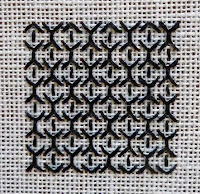 |
| Tulip stitch using two threads of stranded cotton |
New week, new technique: this time it's blackwork.
Apparently it originated in Tudor times (frequently used to decorate collars and cuffs) but the technique the RSN teaches has evolved considerably. It now includes lots of complex patterns and the use of different stitches and threads to vary light and shade. It is stitched on linen, although any evenweave fabric would work (these samples are on Dublin linen with 25 threads per inch).
 | |||
| Interlocking Ys using two threads of stranded cotton |
 |
| Tulip stitch shading |
Tulip stitch here is done with threads of varying thickness: starting at the left one strand of coton à broder, then one strand of stranded cotton and finally one strand of Gutterman's machine sewing thread. The tricky part is blending the varying weights of stitches to avoid seeing a line where the threads change.





